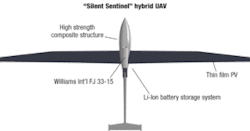THORNTON, Colo.–Ascent Solar Technologies Inc.’s flexible thin-film photovoltaic modules will be designed into a hybrid unmanned aerial vehicle (H-UAV), the Silent Sentinel developed by Bye Aerospace Inc. The H-UAV will be designed primarily for military use; however, its capabilities will also include a broad spectrum of civil applications, according to a company representative.
The first of its kind hybrid uses stored electric power, thin-film solar photovoltaics (PVs), and technologies to enhance its endurance, quiet operation, and low emissions.
Bye Aerospace is teamed with thin-film PV manufacturer Ascent Solar to develop the solar-energy capability on the aircraft.
For primary propulsion, the hybrid UAV will be coupled with an advanced Williams International FJ33 turbofan. The efficient engine will provide the UAV remarkable climb rates and high-altitude quick access to areas requiring surveillance, says a representative.
Charlie Johnson, chief operating officer of Bye Aerospace, considers the Silent Sentinel to be a robust, long-range UAV that will incorporate several proprietary clean-energy features. “Ultimately, it will provide advanced tactical reconnaissance functionality while utilizing a uniquely long-endurance, highly capable tactical sensor platform that is operationally stealthy and cost-effective to operate. The unique characteristics of the Ascent Solar flexible modules allow us to design this UAV to become very energy efficient.”
Dr. Joseph Armstrong, chief technical officer of Ascent Solar Technologies Inc. states: “Our flexible, monolithically integrated CIGS PV technology offers the ideal combination of low weight, higher voltage, and high performance that makes it ideal for applications such as the Silent Sentinel, and we look forward to providing Bye Aerospace the materials they require for their vehicle.”
Potential military applications include border patrol, search and rescue, visual and thermal reconnaissance, and forward air control. In addition, potential civil applications include traffic control, pipeline and power-line inspection, aerial law enforcement, forest fire detection, and aerial photography.
Initial meetings are being conducted with U.S. government entities regarding the capabilities of the aircraft. More are planned in the near term, says an official.

